(word完整版)高中英语作文分类讲解(含例文)
高中英语作文范文解析

高中英语作文范文解析作文是高中英语考试中的重要组成部分,也是对学生综合语言表达能力的一种考察方式。
要想写好英语作文,除了掌握一些基本的写作技巧外,对于一些范文的学习和分析也是至关重要的。
本文将对一篇高中英语作文范文进行解析,帮助大家更好地理解和掌握英语作文的写作方法和技巧。
题目背景范文的题目为“我的英语老师”,是一篇关于介绍自己英语老师的作文。
学生需要从老师的外貌特征、教学方法、个人品质等方面进行描述,以展示他们对老师的了解和赞美之情。
作文结构这篇范文采用了经典的五段式结构,包括引入段、三个主体段落和结尾段。
下面将对每一段进行详细解析。
引入段在引入段中,作者通过一个问句引起读者的兴趣,并简单介绍了他们的英语老师是谁。
这样的引入方式既能吸引读者的注意力,又能迅速给出作文的主题。
同时,作者在引入段中使用了一些形容词和形容性短语,使得文章更加生动有趣。
主体段落一在主体段落一中,作者首先介绍了英语老师的外貌特征,描述了老师的年龄、身材和长相。
随后,作者又通过对老师衣着和发型的描述,展示了老师的时尚和个性。
这些细节的描述让读者更加真实地感受到了老师的形象,也为后面的内容打下了基础。
主体段落二在主体段落二中,作者主要介绍了英语老师的教学方法。
作者认为老师很有耐心,总是耐心地帮助学生解决问题。
同时,老师善于运用丰富的教学资源,采用多种方式进行教学,使学生更容易理解和掌握知识。
此外,作者还赞扬老师对学生的鼓励和激励,使学生在英语学习中保持积极的态度。
主体段落三在主体段落三中,作者从个人品质的角度对英语老师进行了赞美。
作者认为老师热爱教学,对每个学生都非常关心。
老师严格要求学生,鼓励他们不断努力,帮助他们取得好成绩。
此外,老师也是一个善良、乐于助人的人,经常帮助学生解决一些生活上的困难。
通过这些描述,作者成功地展示了他们对英语老师的敬佩之情。
结尾段在结尾段中,作者简单总结了全文,重申了对英语老师的赞美之情,并表达了对老师的感谢之意。
高中英语作文及讲解
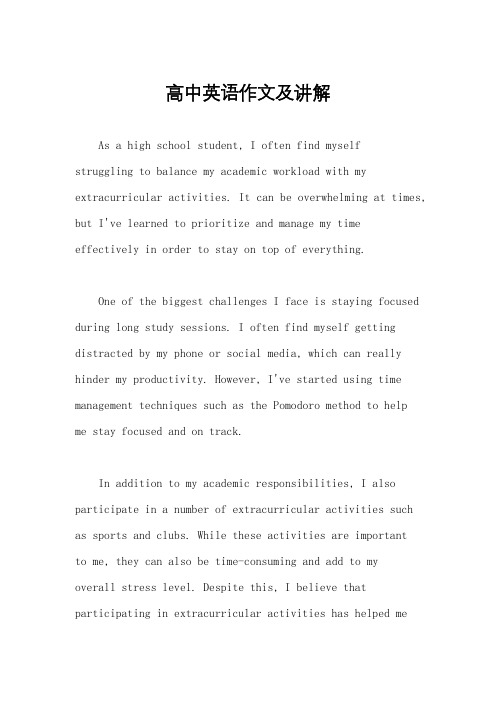
高中英语作文及讲解As a high school student, I often find myselfstruggling to balance my academic workload with my extracurricular activities. It can be overwhelming at times, but I've learned to prioritize and manage my timeeffectively in order to stay on top of everything.One of the biggest challenges I face is staying focused during long study sessions. I often find myself getting distracted by my phone or social media, which can really hinder my productivity. However, I've started using time management techniques such as the Pomodoro method to help me stay focused and on track.In addition to my academic responsibilities, I also participate in a number of extracurricular activities such as sports and clubs. While these activities are importantto me, they can also be time-consuming and add to myoverall stress level. Despite this, I believe that participating in extracurricular activities has helped medevelop important skills such as teamwork and leadership.Another challenge I face is finding time for self-care and relaxation. With such a busy schedule, it can be difficult to find time for myself. However, I've come to realize the importance of taking breaks and engaging in activities that help me relax and recharge, such as reading or spending time with friends and family.Overall, high school can be a challenging time, but I believe that with the right mindset and time management skills, it is possible to succeed both academically and personally. I've learned to prioritize my responsibilities, stay focused, and make time for self-care, all of which have been crucial in helping me navigate the demands of high school life.。
高中英语高考 书面表达 讲解 范文20篇
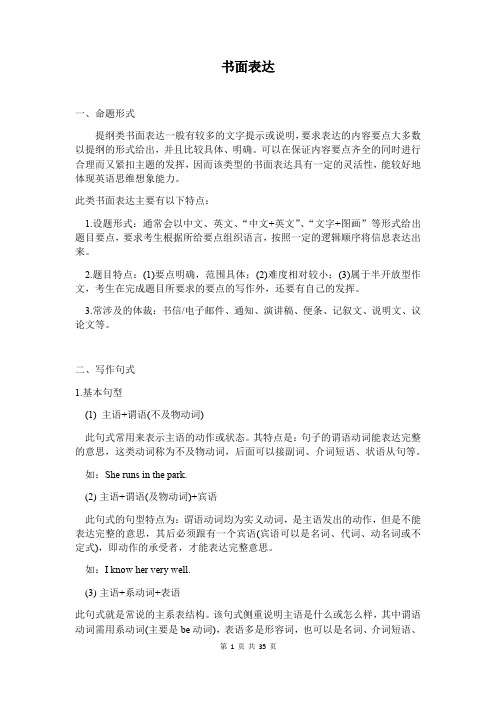
书面表达一、命题形式提纲类书面表达一般有较多的文字提示或说明,要求表达的内容要点大多数以提纲的形式给出,并且比较具体、明确。
可以在保证内容要点齐全的同时进行合理而又紧扣主题的发挥,因而该类型的书面表达具有一定的灵活性,能较好地体现英语思维想象能力。
此类书面表达主要有以下特点:1.设题形式:通常会以中文、英文、“中文+英文”、“文字+图画”等形式给出题目要点,要求考生根据所给要点组织语言,按照一定的逻辑顺序将信息表达出来。
2.题目特点:(1)要点明确,范围具体;(2)难度相对较小;(3)属于半开放型作文,考生在完成题目所要求的要点的写作外,还要有自己的发挥。
3.常涉及的体裁:书信/电子邮件、通知、演讲稿、便条、记叙文、说明文、议论文等。
二、写作句式1.基本句型(1) 主语+谓语(不及物动词)此句式常用来表示主语的动作或状态。
其特点是:句子的谓语动词能表达完整的意思,这类动词称为不及物动词,后面可以接副词、介词短语、状语从句等。
如:She runs in the park.(2)主语+谓语(及物动词)+宾语此句式的句型特点为:谓语动词均为实义动词,是主语发出的动作,但是不能表达完整的意思,其后必须跟有一个宾语(宾语可以是名词、代词、动名词或不定式),即动作的承受者,才能表达完整意思。
如:I know her very well.(3)主语+系动词+表语此句式就是常说的主系表结构。
该句式侧重说明主语是什么或怎么样,其中谓语动词需用系动词(主要是be动词),表语多是形容词,也可以是名词、介词短语、不定式或分词等。
如:He became a teacher.(4)主语+谓语(及物动词)+间接宾语+直接宾语此句式中的谓语动词必须接两个宾语才能表达完整的意思。
其中一个是表示人的间接宾语;另一个是表示物的直接宾语。
一般情况下,间接宾语在前,直接宾语在后。
如:She gave her mother a present.(5)主语+谓语(及物动词)+宾语+宾语补足语此句式中的动词虽然是及物动词,但只接一个宾语还不能表达完整的意思,必须再加上一个补充成分来说明宾语,这样才能使意思完整。
高中 高考英语作文 例题加范文5篇
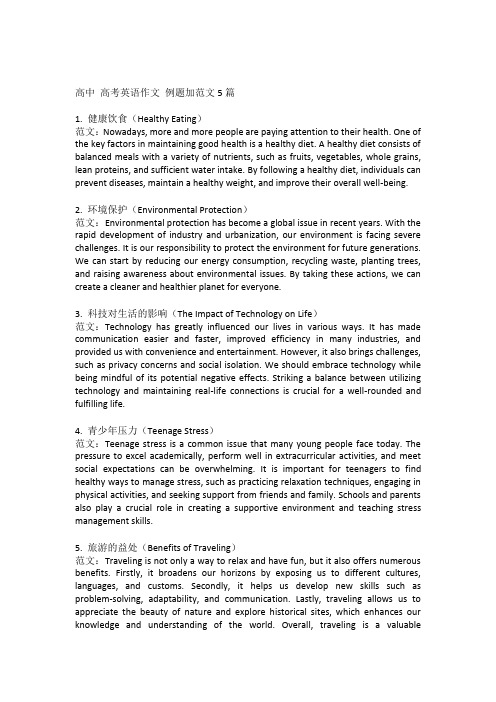
高中高考英语作文例题加范文5篇1. 健康饮食(Healthy Eating)范文:Nowadays, more and more people are paying attention to their health. One of the key factors in maintaining good health is a healthy diet. A healthy diet consists of balanced meals with a variety of nutrients, such as fruits, vegetables, whole grains, lean proteins, and sufficient water intake. By following a healthy diet, individuals can prevent diseases, maintain a healthy weight, and improve their overall well-being. 2. 环境保护(Environmental Protection)范文:Environmental protection has become a global issue in recent years. With the rapid development of industry and urbanization, our environment is facing severe challenges. It is our responsibility to protect the environment for future generations. We can start by reducing our energy consumption, recycling waste, planting trees, and raising awareness about environmental issues. By taking these actions, we can create a cleaner and healthier planet for everyone.3. 科技对生活的影响(The Impact of Technology on Life)范文:Technology has greatly influenced our lives in various ways. It has made communication easier and faster, improved efficiency in many industries, and provided us with convenience and entertainment. However, it also brings challenges, such as privacy concerns and social isolation. We should embrace technology while being mindful of its potential negative effects. Striking a balance between utilizing technology and maintaining real-life connections is crucial for a well-rounded and fulfilling life.4. 青少年压力(Teenage Stress)范文:Teenage stress is a common issue that many young people face today. The pressure to excel academically, perform well in extracurricular activities, and meet social expectations can be overwhelming. It is important for teenagers to find healthy ways to manage stress, such as practicing relaxation techniques, engaging in physical activities, and seeking support from friends and family. Schools and parents also play a crucial role in creating a supportive environment and teaching stress management skills.5. 旅游的益处(Benefits of Traveling)范文:Traveling is not only a way to relax and have fun, but it also offers numerous benefits. Firstly, it broadens our horizons by exposing us to different cultures, languages, and customs. Secondly, it helps us develop new skills such as problem-solving, adaptability, and communication. Lastly, traveling allows us to appreciate the beauty of nature and explore historical sites, which enhances our knowledge and understanding of the world. Overall, traveling is a valuableexperience that enriches our lives.。
高中英语作文分类讲解(含例文)
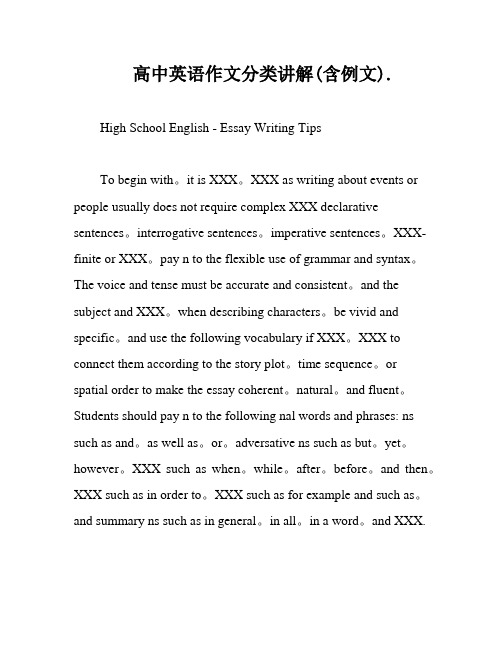
高中英语作文分类讲解(含例文).High School English - Essay Writing TipsTo begin with。
it is XXX。
XXX as writing about events or people usually does not require complex XXX declarative sentences。
interrogative sentences。
imperative sentences。
XXX-finite or XXX。
pay n to the flexible use of grammar and syntax。
The voice and tense must be accurate and consistent。
and the subject and XXX。
when describing characters。
be vivid and specific。
and use the following vocabulary if XXX。
XXX to connect them according to the story plot。
time sequence。
or spatial order to make the essay coherent。
natural。
and fluent。
Students should pay n to the following nal words and phrases: ns such as and。
as well as。
or。
adversative ns such as but。
yet。
however。
XXX such as when。
while。
after。
before。
and then。
XXX such as in order to。
XXX such as for example and such as。
高中英语 高考英语作文 例题加范文5篇
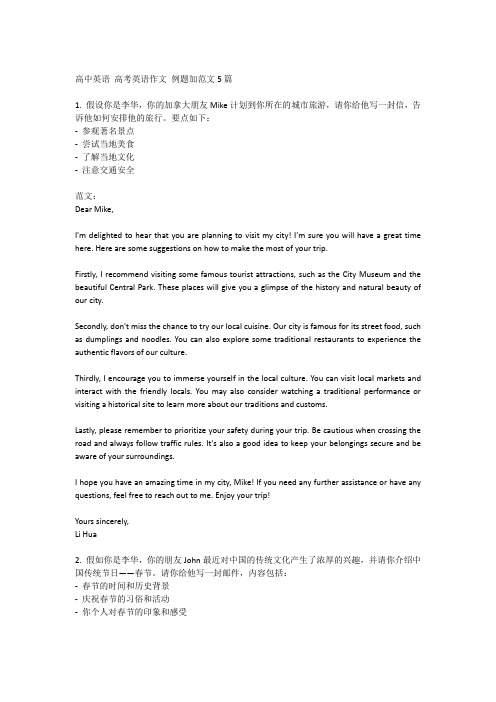
高中英语高考英语作文例题加范文5篇1. 假设你是李华,你的加拿大朋友Mike计划到你所在的城市旅游,请你给他写一封信,告诉他如何安排他的旅行。
要点如下:-参观著名景点-尝试当地美食-了解当地文化-注意交通安全范文:Dear Mike,I'm delighted to hear that you are planning to visit my city! I'm sure you will have a great time here. Here are some suggestions on how to make the most of your trip.Firstly, I recommend visiting some famous tourist attractions, such as the City Museum and the beautiful Central Park. These places will give you a glimpse of the history and natural beauty of our city.Secondly, don't miss the chance to try our local cuisine. Our city is famous for its street food, such as dumplings and noodles. You can also explore some traditional restaurants to experience the authentic flavors of our culture.Thirdly, I encourage you to immerse yourself in the local culture. You can visit local markets and interact with the friendly locals. You may also consider watching a traditional performance or visiting a historical site to learn more about our traditions and customs.Lastly, please remember to prioritize your safety during your trip. Be cautious when crossing the road and always follow traffic rules. It's also a good idea to keep your belongings secure and be aware of your surroundings.I hope you have an amazing time in my city, Mike! If you need any further assistance or have any questions, feel free to reach out to me. Enjoy your trip!Yours sincerely,Li Hua2. 假如你是李华,你的朋友John最近对中国的传统文化产生了浓厚的兴趣,并请你介绍中国传统节日——春节。
高中 高考英语作文 例题加范文5篇
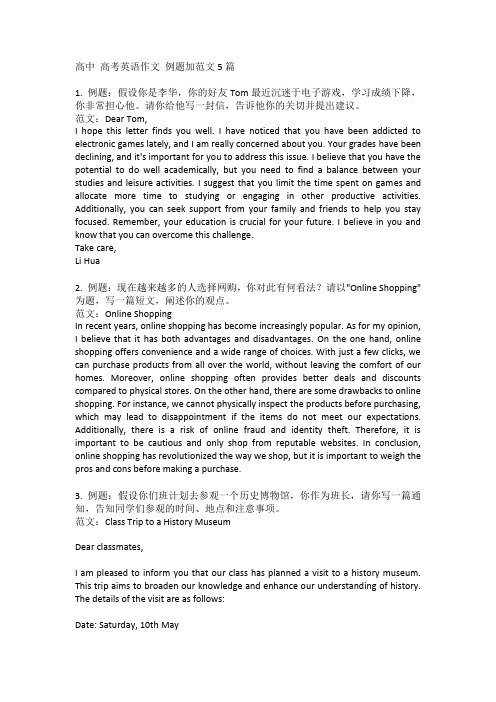
高中高考英语作文例题加范文5篇1. 例题:假设你是李华,你的好友Tom最近沉迷于电子游戏,学习成绩下降,你非常担心他。
请你给他写一封信,告诉他你的关切并提出建议。
范文:Dear Tom,I hope this letter finds you well. I have noticed that you have been addicted to electronic games lately, and I am really concerned about you. Your grades have been declining, and it's important for you to address this issue. I believe that you have the potential to do well academically, but you need to find a balance between your studies and leisure activities. I suggest that you limit the time spent on games and allocate more time to studying or engaging in other productive activities. Additionally, you can seek support from your family and friends to help you stay focused. Remember, your education is crucial for your future. I believe in you and know that you can overcome this challenge.Take care,Li Hua2. 例题:现在越来越多的人选择网购,你对此有何看法?请以"Online Shopping"为题,写一篇短文,阐述你的观点。
英语作文万能模板高中带翻译范文

英语作文万能模板高中带翻译范文Title: High School English Essay Template with Translation Sample。
Introduction。
In this essay, we will discuss the structure and content of a high school English essay template. We will also provide a sample essay with a Chinese translation to help students understand the format and language used in the essay.I. Introduction。
The introduction of a high school English essay should provide background information on the topic and present a clear thesis statement. The thesis statement should clearly state the main argument or point of the essay.Sample:The topic of this essay is the importance of environmental protection. Environmental protection is a crucial issue that affects the well-being of our planet and future generations. This essay will argue that individuals and governments need to take action to protect the environment in order to ensure a sustainable future for all.Translation:本文的主题是环境保护的重要性。
高中英语 高考英语作文 例题加范文5篇

高中英语高考英语作文例题加范文5篇1. 话题:环境保护请根据以下提示,写一篇短文,谈谈你对环境保护的看法。
提示:1)环境污染的问题日益严重;2)造成环境污染的原因;3)个人应该如何保护环境。
范文:Environmental ProtectionThe issue of environmental pollution has become increasingly severe in recent years. The main causes of environmental pollution include industrial emissions, vehicle exhausts, and improper waste disposal. As individuals, we have a responsibility to protect the environment.Firstly, we can reduce pollution by conserving energy and resources. For example, we should turn off lights when we leave a room, use public transportation or carpool whenever possible, and recycle waste products. Secondly, we must raise awareness about environmental protection. This can be done through education and public campaigns. The more people understand the importance of protecting the environment, the more actions will be taken to address the issue.In conclusion, environmental protection is crucial for the well-being of our planet and future generations. We must take immediate action to reduce pollution and promote sustainable practices. Let's work together to create a cleaner and healthier environment.2. 话题:青少年沉迷手机请根据以下提示,写一篇短文,谈谈你对青少年沉迷手机的看法。
英语作文带例文解析高中
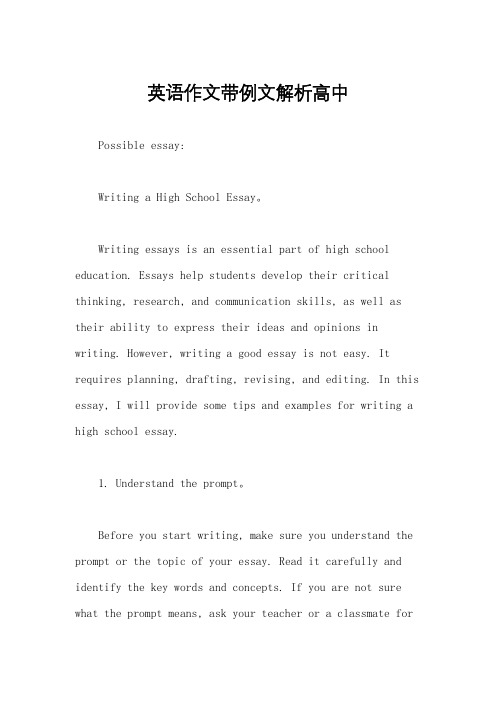
英语作文带例文解析高中Possible essay:Writing a High School Essay。
Writing essays is an essential part of high school education. Essays help students develop their critical thinking, research, and communication skills, as well as their ability to express their ideas and opinions in writing. However, writing a good essay is not easy. It requires planning, drafting, revising, and editing. In this essay, I will provide some tips and examples for writing a high school essay.1. Understand the prompt。
Before you start writing, make sure you understand the prompt or the topic of your essay. Read it carefully and identify the key words and concepts. If you are not sure what the prompt means, ask your teacher or a classmate forclarification. For example, if the prompt is "Discuss the impact of social media on teenagers," you need to know what social media is, what impact means, and what teenagersrefer to.2. Brainstorm ideas。
(完整word版)人教版英语必修一二各单元写作训练及参考范文
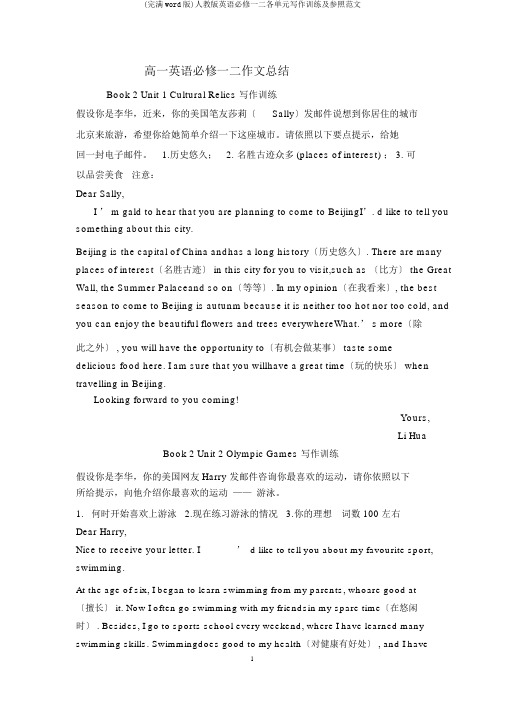
高一英语必修一二作文总结Book 2 Unit 1 Cultural Relics 写作训练假设你是李华,近来,你的美国笔友莎莉〔Sally〕发邮件说想到你居住的城市北京来旅游,希望你给她简单介绍一下这座城市。
请依照以下要点提示,给她回一封电子邮件。
1.历史悠久; 2. 名胜古迹众多 (places of interest) ; 3. 可以品尝美食注意:Dear Sally,I ’ m gald to hear that you are planning to come to BeijingI’. d like to tell you something about this city.Beijing is the capital of China andhas a long history〔历史悠久〕. There are many places of interest〔名胜古迹〕 in this city for you to visit,such as 〔比方〕 the Great Wall, the Summer Palaceand so on〔等等〕. In my opinion〔在我看来〕, the best season to come to Beijing is autunm because it is neither too hot nor too cold, and you can enjoy the beautiful flowers and trees everywhereWhat.’ s more〔除此之外〕 , you will have the opportunity to〔有机会做某事〕 taste somedelicious food here. I am sure that you willhave a great time〔玩的快乐〕 when travelling in Beijing.Looking forward to you coming!Yours,Li HuaBook 2 Unit 2 Olympic Games 写作训练假设你是李华,你的美国网友 Harry 发邮件咨询你最喜欢的运动,请你依照以下所给提示,向他介绍你最喜欢的运动——游泳。
(完整word版)高中英语作文:用好非谓语动词,提升写作档次

高中英语作文:用好非谓语动词,提升写作档次众所周知,作文中出现过多的简单句会让人觉得单调乏味,句子与句子之间的关系显得松散;而文章中过多地出现复合句又显得累赘,读起来费劲.恰当地运用非谓语动词对简单句和复合句进行转换,不仅句型多样,句子活泼,而且读起来结构紧凑,言简意明。
1.我为那事感到非常遗憾,开始考虑做些什么来帮一下.I feel quite sorry for that。
I begin to think about what to do to help。
→Feeling quite sorry for that, I begin to think about what to do to help.(现在分词作状语)2.另一方面,我将帮着建立英语角,给我们学生提供一个练习英语口语的平台。
On the other hand, I will help set up the English corner。
It will provide us students a platform to practice our oral English.→On the other hand, I will help set up the English corner, providing us students a platform to practice our oral English。
(现在分词作状语)3.这儿的人都喜欢汤姆写的那本小说。
All the people here like the novel。
It is written by Tom。
→All the people here like the novel written by Tom.(过去分词作定语)4.我们应该多讲英语。
我们认为这是很重要的.We should speak more English。
We think it is very important.→We think it very important to speak more English.(it作形式宾语,不定式作真正宾语)5.我们应该如何提高我们的英语口语水平?这是个问题.How should we improve our spoken English? It is a question.→How to improve our spoken English is a question.(不定式短语作主语)→The question is how to improve our spoken English。
高中简单常考英语作文范文加分析
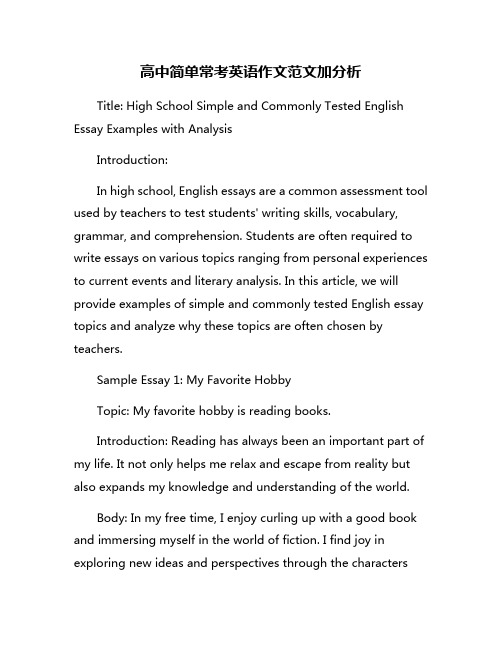
高中简单常考英语作文范文加分析Title: High School Simple and Commonly Tested English Essay Examples with AnalysisIntroduction:In high school, English essays are a common assessment tool used by teachers to test students' writing skills, vocabulary, grammar, and comprehension. Students are often required to write essays on various topics ranging from personal experiences to current events and literary analysis. In this article, we will provide examples of simple and commonly tested English essay topics and analyze why these topics are often chosen by teachers.Sample Essay 1: My Favorite HobbyTopic: My favorite hobby is reading books.Introduction: Reading has always been an important part of my life. It not only helps me relax and escape from reality but also expands my knowledge and understanding of the world.Body: In my free time, I enjoy curling up with a good book and immersing myself in the world of fiction. I find joy in exploring new ideas and perspectives through the charactersand stories I encounter in books. Reading has also improved my vocabulary and critical thinking skills, making me a better communicator and problem solver.Conclusion: Reading is not just a hobby for me; it is a way of life that enriches my mind and soul.Analysis: This topic is often chosen by teachers because it allows students to express their personal interests and experiences in a creative way. It also tests students' ability to organize their thoughts coherently and effectively communicate their ideas. Additionally, writing about hobbies helps students develop their descriptive writing skills and vocabulary.Sample Essay 2: The Importance of EducationTopic: Education is the key to success.Introduction: Education opens doors to opportunities and helps individuals reach their full potential. It is a powerful tool that empowers people to achieve their goals and make a positive impact on society.Body: Through education, individuals gain knowledge, skills, and confidence to pursue their dreams and contribute to the development of society. Education also promotes criticalthinking, creativity, and innovation, which are essential for personal and professional growth.Conclusion: Investing in education is investing in the future. It is the foundation upon which individuals can build successful careers, achieve financial stability, and make a difference in the world.Analysis: This topic is commonly tested in high school essays because it encourages students to reflect on the value of education in their lives and society. It also allows students to explore the benefits of learning and the role of education in shaping their future. Writing about the importance of education helps students develop their argumentative writing skills and articulate their views on a relevant and significant topic.Conclusion:High school English essays play a crucial role in assessing students' writing abilities, critical thinking skills, and creativity. By providing students with simple and commonly tested essay topics, teachers can help students improve their writing proficiency and express their ideas effectively. Through practice and feedback, students can develop their writing skills and become more confident communicators. Therefore, it is important for students to engage actively in writing essays andembrace the opportunities for self-expression and growth that these assignments offer.。
高考英语作文范文素材10篇(中英双语)

高考英语作文范文素材10篇(中英双语)第一篇:Essay 1: The Importance of EducationEducation plays a crucial role in shaping individuals and societies. It equips us with knowledge, skills, and values necessary for personal and societal development. Firstly, education provides us with a foundation of knowledge, enabling us to understand the world around us. Furthermore, it helps cultivate critical thinking and problem-solving skills, essential for success in the modern world. Lastly, education promotes social cohesion and equality by fostering empathy, tolerance, and understanding among individuals from diverse backgrounds. Therefore, it is imperative that we recognize and prioritize the significance of education in our lives.中文翻译:范文1:教育的重要性教育在塑造个人和社会方面起着至关重要的作用。
它赋予我们理解周围世界所需的知识、技能和价值观。
首先,教育为我们提供了知识的基础,使我们能够了解周围世界。
此外,它帮助培养批判思维和解决问题的能力,这对于在现代社会取得成功至关重要。
中学英文作文解析范文高中
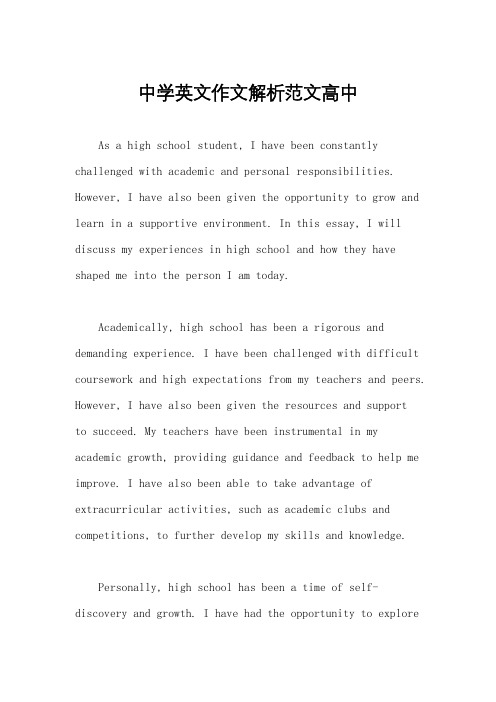
中学英文作文解析范文高中As a high school student, I have been constantly challenged with academic and personal responsibilities. However, I have also been given the opportunity to grow and learn in a supportive environment. In this essay, I will discuss my experiences in high school and how they have shaped me into the person I am today.Academically, high school has been a rigorous and demanding experience. I have been challenged with difficult coursework and high expectations from my teachers and peers. However, I have also been given the resources and supportto succeed. My teachers have been instrumental in my academic growth, providing guidance and feedback to help me improve. I have also been able to take advantage of extracurricular activities, such as academic clubs and competitions, to further develop my skills and knowledge.Personally, high school has been a time of self-discovery and growth. I have had the opportunity to exploremy interests and passions, and to develop my own identity.I have made new friends and formed meaningful relationships with my peers and teachers. I have also faced challenges and setbacks, but these experiences have taught me resilience and perseverance.One of the most important lessons I have learned in high school is the value of hard work and dedication. Success in high school requires consistent effort and commitment, and I have learned to prioritize my time and manage my responsibilities effectively. I have also learned the importance of setting goals and working towards them with determination and focus.Another important lesson I have learned is the value of diversity and inclusivity. High school has exposed me to a wide range of perspectives and experiences, and I have learned to appreciate the differences that make us unique.I have also learned the importance of empathy and understanding, and the impact that small acts of kindness and compassion can have on others.In conclusion, high school has been a transformative experience for me. It has challenged me academically and personally, and has provided me with the resources and support to succeed. I have learned important lessons about hard work, dedication, diversity, and empathy, and I am grateful for the opportunities I have had to grow and learn. As I move forward in life, I will carry these lessons with me and continue to strive for excellence and personal growth.。
高中简单英语作文加解析
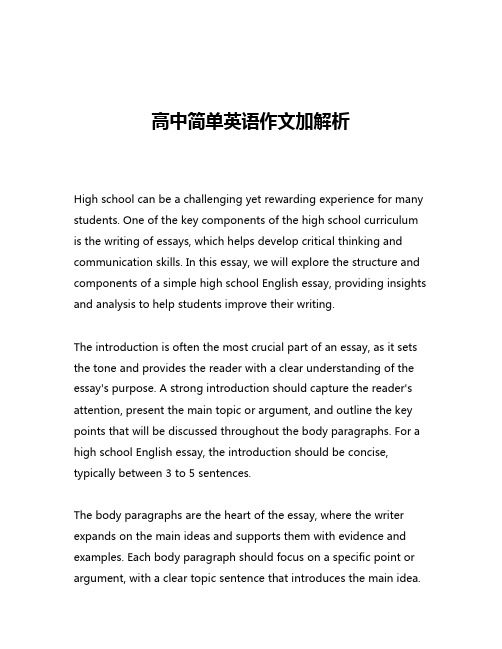
高中简单英语作文加解析High school can be a challenging yet rewarding experience for many students. One of the key components of the high school curriculum is the writing of essays, which helps develop critical thinking and communication skills. In this essay, we will explore the structure and components of a simple high school English essay, providing insights and analysis to help students improve their writing.The introduction is often the most crucial part of an essay, as it sets the tone and provides the reader with a clear understanding of the essay's purpose. A strong introduction should capture the reader's attention, present the main topic or argument, and outline the key points that will be discussed throughout the body paragraphs. For a high school English essay, the introduction should be concise, typically between 3 to 5 sentences.The body paragraphs are the heart of the essay, where the writer expands on the main ideas and supports them with evidence and examples. Each body paragraph should focus on a specific point or argument, with a clear topic sentence that introduces the main idea.The supporting details, such as facts, quotes, or explanations, should be presented in a logical and coherent manner, helping to build a strong case for the writer's position.In a high school English essay, the body paragraphs should be well-structured, with each paragraph containing approximately 5 to 7 sentences. The transitions between paragraphs are also important, as they help the reader understand the flow of the essay and the connection between the different points being made.The conclusion is the final part of the essay, where the writer ties together the main ideas and reinforces the overall argument or message. A strong conclusion should summarize the key points, provide a sense of closure, and leave the reader with a lasting impression. For a high school English essay, the conclusion should be concise, typically between 3 to 5 sentences.Throughout the essay, it is important to maintain a clear and consistent tone, using appropriate language and avoiding overly complex or technical vocabulary. High school students should strive to write in a clear, concise, and engaging manner, ensuring that their ideas are communicated effectively to the reader.In addition to the structure and content of the essay, it is also important to consider the mechanics of writing, such as grammar,spelling, and punctuation. High school students should be mindful of these elements, as they can significantly impact the overall quality and clarity of the essay.One common mistake that high school students make is the overuse of passive voice. While passive voice can be appropriate in certain situations, it is generally preferable to use active voice, which is more direct and engaging. For example, instead of writing "The book was read by the student," the active voice version would be "The student read the book."Another common issue is the misuse of commas, which can often lead to confusion or ambiguity. High school students should familiarize themselves with the basic rules of comma usage, such as separating independent clauses, setting off introductory phrases, and enclosing nonessential information.Finally, it is important for high school students to proofread their essays carefully, checking for any errors or inconsistencies. This step can help ensure that the final product is polished and professional, reflecting the student's best work.In conclusion, the writing of a simple high school English essay can be a valuable exercise in developing critical thinking and communication skills. By understanding the structure andcomponents of an effective essay, as well as the importance of mechanics and proofreading, high school students can improve their writing and prepare themselves for the challenges of higher education and beyond.。
高中英语作文分类讲解(含例文)

高中英语作文分类讲解(含例文)High School English - Essay Writing TipsLooking back at the exam。
the following are some key points and hot topics to review:1.Writing XXX:Firstly。
avoid using Chinese-style English and try to use XXX.Secondly。
XXX declarative sentences。
interrogative sentences。
XXX-finite or XXX.Thirdly。
pay n to the flexible use of grammar and syntax。
The voice and XXX: XXX.Fourthly。
when describing characters。
be vivid and specific。
You can choose to use the following vocabulary.Fifthly。
XXX。
n。
etc。
according to the story plot。
the order of occurrence of the story (time or space) to make the article coherent。
natural and smooth。
Students should pay n to the following nal usage: XXX "and"。
"as well"。
"or"。
XXX "but"。
"yet"。
"however"。
XXX "when"。
"while"。
高中英语 高考英语作文 例题加范文3篇
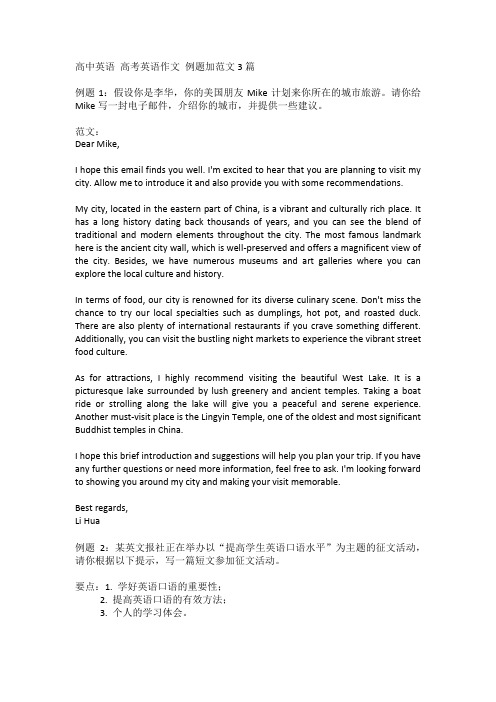
高中英语高考英语作文例题加范文3篇例题1:假设你是李华,你的美国朋友Mike计划来你所在的城市旅游。
请你给Mike写一封电子邮件,介绍你的城市,并提供一些建议。
范文:Dear Mike,I hope this email finds you well. I'm excited to hear that you are planning to visit my city. Allow me to introduce it and also provide you with some recommendations.My city, located in the eastern part of China, is a vibrant and culturally rich place. It has a long history dating back thousands of years, and you can see the blend of traditional and modern elements throughout the city. The most famous landmark here is the ancient city wall, which is well-preserved and offers a magnificent view of the city. Besides, we have numerous museums and art galleries where you can explore the local culture and history.In terms of food, our city is renowned for its diverse culinary scene. Don't miss the chance to try our local specialties such as dumplings, hot pot, and roasted duck. There are also plenty of international restaurants if you crave something different. Additionally, you can visit the bustling night markets to experience the vibrant street food culture.As for attractions, I highly recommend visiting the beautiful West Lake. It is a picturesque lake surrounded by lush greenery and ancient temples. Taking a boat ride or strolling along the lake will give you a peaceful and serene experience. Another must-visit place is the Lingyin Temple, one of the oldest and most significant Buddhist temples in China.I hope this brief introduction and suggestions will help you plan your trip. If you have any further questions or need more information, feel free to ask. I'm looking forward to showing you around my city and making your visit memorable.Best regards,Li Hua例题2:某英文报社正在举办以“提高学生英语口语水平”为主题的征文活动,请你根据以下提示,写一篇短文参加征文活动。
- 1、下载文档前请自行甄别文档内容的完整性,平台不提供额外的编辑、内容补充、找答案等附加服务。
- 2、"仅部分预览"的文档,不可在线预览部分如存在完整性等问题,可反馈申请退款(可完整预览的文档不适用该条件!)。
- 3、如文档侵犯您的权益,请联系客服反馈,我们会尽快为您处理(人工客服工作时间:9:00-18:30)。
高中英语——作文讲解一、考点、热点回顾1.写作技巧:首先,要避免使用汉语式英语,尽量使用自己熟悉的句型。
其次,多用简单句型,记事、写人一般都不需要复杂的句型。
可适当多使用陈述句、一般疑问句、祈使句和感叹句。
不用或少用非谓语或独立主格结构等较复杂的句型。
第三,注意语法句法的灵活运用。
语态、时态要准确无误:主谓语要一致。
第四,描写人物时,要生动具体,可以选择使用下列词汇。
第五,上下文要连贯。
同学们应把写好的句子,根据故事情节、故事发生的先后次序(时间或空间).使用一些表示并列、递进等过渡词进行加工整理.使文章连贯、自然、流畅。
同学们应注意下面过渡的用法一并列关系:and、as well、or,转折关系:but、yet、however,时间关系:when、while、after、before、th即、正er that,因果关系:so、therefore。
目的:in order to、.列举:for example、such as,总结性:in general、in all、in a word、generally speaking避免病句。
2.注意事项:(1)在整篇文章中,避免只是用一、两个句式。
要灵活运用各种句式。
如倒装句、强调句、省略句、主从复合句、对比句、分词短语、介词短语等。
(2).使用不同长度的句子,通过分句和合句,增强句子的连贯性和表现力。
(3).改变句子的开头方式,不要一味以主、谓、宾、状的次序。
可以把状语至于句首,或用分词等。
(4).学会使用过渡词。
递进furthermore, moreover, besides, in addition, then, etc.转折however, but, nevertheless, afte rwards,etc.总结finally, at last, in brief ,to conclude,etc.强调really, indeed, ce rtainly, surely, above all,etc.对比in the same way, just as, on the otherhand,etc.(5). 避免重复使用同一单词或词组。
(6). 确定文章用第几人称写, 基本时态是什么。
3. 检查错误:(1)看字数是否达到要求,看有无遗漏要点。
(2)看文体格式是否正确规范。
(3)看有无语法或用词上的错误。
(4)看单词拼写、字母大小写是否有错.标点符号是否有无遗漏或用错等等。
(5)注意时态、语态、人称是否上下文一致。
4.常用短语:①给观点分组讨论类开头模版Recently, we had a heated discussion on…..论述观点when it comes to this hot topic ,students' views vary from people to people ,some people think that …,nevertheless , just as the saying goes" every coin has two sides " ,so others have the opposite opinion , they consider that …结尾as far as I concerned, I think that …②一些精彩亮点连接词in addition , what"s more , furthermoremoreover(另外)last but not least important ,most important (最重要的是)worst of all (最糟糕的是),to make matters wores(更糟的是)as far as I concerned, personally(我个人看来)however , nevertheless(然而)二、典型例题1. 英语书信的常见写作模板:开头部分:How nice to hear from you again.Let me tell you something about the activity.I’m glad to have received your letter of Apr. 9th.I’m pleased to hear that you’re coming to China for a visit.I’m writing to thank you for your help during my stay in America.结尾部分:With best wishes.I’m l ooking forward to your reply.I’d appreciate it if you could reply earlier.例文:假设你是李华。
你的外国笔友Jane打算于七月来中国,特来信了解中国的社交习俗。
请你用英语回一封信,从以下几个方面做具体介绍。
1.见面时的问候方式;2.对赞美的回答方式;3.接受礼物时的回应方式;4.餐晏礼节。
注意:1.词数100左右,信的开头和结束语已为你写好(不计入总词数)。
2.可根据内容要点适当增加细节,使行文连贯。
Dear Jane,Glad to hear from you and you’re welcome to China in July.I hope what’s mentioned above might be helpful and wish you a good journey.YoursSincerely,Li HuaDear Jane,Glad to hear from you and you’re welcome to China in July. The following are some Chinese customs.Firstly, we greet each other by saying “Hello” or asking such questions as “Where are you going?” or “Are you busy?” to express our care. Secondly, when praised, we reply with “Oh, no!” or “I’m over-praised”to show good manners. Next, when receiving a gift, we usually say “It’s unnecessary” besides “Thanks” to show politeness and then put it away. Finally, at dinner parties, we talk loudly and touch glasses when drinking to someone’s health or success to show that we’re warm.Anyhow, different cultures, different customs. If you “Do as the Romans do when in Rome”, you’ll enjoy more of your stay here.I hope what’s mentioned above might be helpful and wish you a good journey.Yours sincerely,Li Hua2.议论文模板(1).正反观点式议论文模板导入:第1段:Recently we’ve had a discussion about whe ther we should... (导入话题)Our opinions are divided on this topic.(观点有分歧)正文:第2段:Most of the students are in favour of it.(正方观点)Here are the reasons. First... Second... Finally...(列出2~3个赞成的理由)第3段:However, the others are strongly against it. (反方观点)Their reasons are as follows. In the first place... What’s more... In addition...(列出2~3个反对的理由)结论:第4段:Personally speaking, the advantages overweigh the disadvantages, for it will do us more harm than good, so I support it.(个人观点)オ例文最近,你校同学正在参加某英文报组织的一场讨论。
讨论的主题是:公园要不要收门票?请你根据下表所提供的信息,给报社写一封信,客观地介绍讨论情况。
60%的同学认为 1.不应该收门票 2.公园是公众休闲的地方 3.如收门票,需建大门、围墙,会影响城市形象40%的同学认为 1.应收门票,但票价不要太高2.支付园林工人工资 3.购新花木注意:1.信的开头已为你写好。
2.词数:100左右。
3.参考词汇:门票---entrance feeDear Editor.I’m writing to tell you about the discussion we have had aboutwhether an entrance fee should be charged for parks.Dear editor,I’m writing to tell you about the discussion we have had about whether an entrance fee should be charged for parks. Sixty percent of my schoolmates are for the idea that an entrance fee should not be forced on the pu blic. They believe parks are the place where the public enjoy themselves at their leisure. They think that a gat e and wails are to be built if an entrance fee is to be charged. The city will not look so beautiful as it should h ave. Forty percent of my schoolmates are for the idea that an entrance fee is OK, but it shouldn’t be out of co ntrol. Entrance fee can be used to pay the gardeners and buy new types of flowers and trees. For myself, I’d like to say that if we all work hard to build our city into a flower garden, who cares about the entrance fee f or parks?Yours truly,Li Hua(2) .观点论述类议论文模板:导入:第1段:提出一种现象或某个决定作为议论的话题As a student, I am strongly in favour of the decision. (亮明自己的观点是赞成还是反对)The reasons for this may be listed as follows. (过渡句,承上启下)正文:第2段:First of all... Secondly... Besides...(列出2~3个赞成或反对的理由)结论:第3段:In conclusion, I believe that... (照应第1段,构成"总—分—总"结构)(3).“A或者B”类议论文模板:导入:第1段:Some people hold the opinion that A is superior to B in many ways. Others, however, argue that B is much better. Personally, I would prefer A because I think A has more advantages.正文:第2段:There are many reasons why I prefer A. The main reason is that ... Another reason is that...(赞同A的原因)第3段: Of course, B also has advantages to some extent... (列出1~2个B的优势)结论:第4段: But if all these factors are considered, A is much better than B. From what has been discussed above, we may finally draw the conclusion that ...(得出结论) オ3. 图表作文写作模板:The chart gives us an overall picture of the 图表主题. The first thing we notice is that 图表最大特点. This means that as (进一步说明).We can see from the statistics given that 图表细节一. After 动词-ing 细节一中的第一个变化,the动词-ed+幅度+时间(紧跟着的变化) . The figures also tell us that图表细节二. Inthe column, we can see that accounts for (进一步描述).Judging from these figures, we can draw the conclusion that (结论). The reason for this, as far as I am concerned is that (给出原因). / It is high time that we (发出倡议).4、图画类写作模板:1.开头Look at this picture./The picture shows that.../From this picture, we can see.../As is shown in the picture.../As is seen in the picture...2.衔接句As we all know, .../As is known to all,.../It is well known that.../In my opinion,.../As far as I am concerned,.../This sight reminds me of something in my daily life.3.结尾句In conclusion.../In brief.../On the whole.../In short.../In a word.../Generally speaking.../As has been stated...例文:你校学生会准备办一期英语墙报,主题为:保护环境从我做起。
